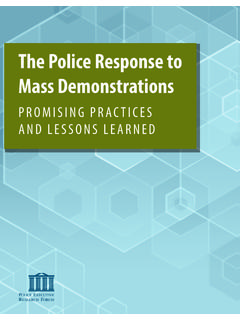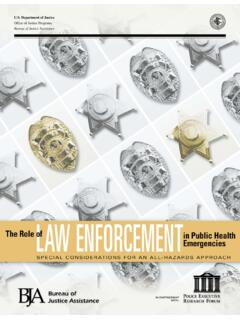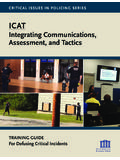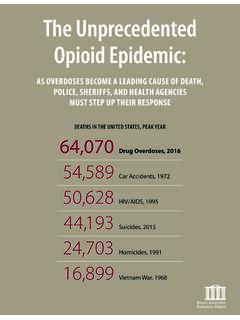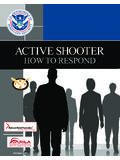Transcription of The Police Response to Active Shooter Incidents
1 CRITICAL ISSUES IN POLICING SERIESThe Police Response to Active Shooter IncidentsPage intentionally blankCRITICAL ISSUES IN POLICING SERIESThe Police Response to Active Shooter IncidentsMarch 2014 This publication was supported by the Motorola Solutions Foundation. The points of view expressed herein are the authors and do not necessarily represent the opinions of the Motorola Solutions Foundation or individual Police Executive Research Forum Executive Research Forum, Washington, 20036 Copyright 2014 by Police Executive Research ForumAll rights reservedPrinted in the United States of AmericaISBN: 978-1-934485-23-1 Cover and text page design by Dave by James ..iIntroduction ..1 Analysis of 84 Active Shooter Incidents Since 2000 ..3 Variations Found in Policies on Active Shooter Response ..8 Sidebar: Characteristics of Active Shooters ..9 The Police Response to Active Shooter Incidents , and Changes in Officer Training.
2 16 Sidebar: January 2014 Shooting in Maryland Shopping Mall Tested Capabilities of Howard County Police ..18 Sidebar: Police and Fire Departments in Arlington County, VA Create Rescue Task Forces to Speed Medical Care ..22 Sidebar: Shooting at the Washington Navy Yard Metropolitan Police Department: Identified Issues and Challenges ..24 Sidebar: Takeaways and Suggestions ..28 Preventing the Next Active Shooter Incident ..29 What Police Should Tell the Community ..37 Conclusion ..40 Resources ..41 About the Police Executive Research Forum ..43 About Motorola Solutions and the Motorola Solutions Foundation ..45 Appendix: Participants at the PERF Summit The Police Response to Active Shooter Incidents ..46 Acknowledgments iAcknowledgmentsIn the summer of 2012, following the mass shooting event at the Century movie theater in Aurora, Colorado, PERF decided to conduct a Critical Issues in Policing project on the topic of Active shooters.
3 During the fall months, PERF was conduct-ing research and preparing for a national Summit where Police chiefs and others would discuss the changes in policies, training, and strategies that have resulted from the onset of Active - Shooter , on December 14, the nation got word of a new Active shooting incident, in Newtown, Con-necticut, which was one of the most horrific of all of these heinous crimes, because most of the vic-tims were very young children. We held our Sum-mit in February 2013, and the shooting at the Sandy Hook Elementary School in Newtown was fresh in everyone s minds, as we discussed the approaches to these Incidents that are detailed in this is grateful to the Motorola Solutions Foundation for its generous support of the Critical Issues in Policing series. Once again, our colleagues at Motorola have provided PERF with the flexibility to take on the most difficult issues in policing as the issues emerge.
4 PERF s partnership with the Motor-ola Solutions Foundation has resulted in many of PERF s most significant projects in the areas of research and policy development. Specifically, I want to thank Greg Brown, Chair-man and CEO of Motorola Solutions; Mark Moon, Executive Vice President and President, Sales and Product Operations; Jim Welch, Senior Vice Presi-dent, Americas Region; Domingo Herraiz, Vice President, North America Government Affairs; and Matt Blakely, Director of the Motorola Solutions Foundation. Our friend Rick Neal, recently retired from Motorola Solutions, played a key role in get-ting this project off the also want to thank all of the PERF members and other experts who participated in our Active Shooter Summit on February 13, 2013. Special thanks go to the Police chiefs who have experienced Active Shooter Incidents , including Aurora Chief Dan Oates, Colonel Danny Stebbins of the Connect-icut Department of Public Safety, the lead agency investigating the Sandy Hook mass shooting, How-ard County, MD Chief William McMahon, who led the Response to a shopping mall shooting in January 2014, and Chief Cathy Lanier of Washington, s Metropolitan Police Department, which responded to the Washington Navy Yard mass shooting inci-dent in September 2013.
5 Chief Terry Gainer, Senate Sergeant at Arms, Capitol Police Chief Kim Dine, and my former Executive Assistant Tam Vieth, who is now with Customs and Border Protection, deserve spe-cial thanks. They arranged for our Summit to be held in the historic Senate Caucus Room in the Russell Senate Office Building. (This room, pictured on the cover of this report, has served as the site of some of the most dramatic Senate hearings for more than 100 years, including hearings on the sinking of the Titanic in 1912, the Teapot Dome Scandal in 1923, the Army-McCarthy hearings in 1954, and the Watergate investigation in 1973.)We are also grateful to Prof. Pete Blair of Texas State University, who made two important presen-tations at our Summit. In the first, he shared the results of groundbreaking research that he and his colleagues have conducted on 84 Active shooting Incidents between 2000 and 2010.
6 Professor Blair s research is especially informative because it was conducted from a law enforcement perspective. And in his second presentation, Professor Blair dis-cussed how Police can educate the public about how to protect themselves if they are ever present at an ii Acknowledgmentsactive Shooter thanks to PERF members who provided us with copies of their Active Shooter policies, training protocols, videos, PowerPoints, and other informa-tion. These documents provided important per-spectives on the actual practices of Police agencies, in an area that has been changing since the Colum-bine shooting of 1999 and is continuing to evolve with each new mass shooting , I want to thank the PERF staff members who worked on this project, starting with my Chief of Staff, Andrea Luna, and PERF s former Direc-tor of Program Development, Sheryl Goldstein.
7 Andrea has been leading Motorola Solutions Foun-dation projects for many years, and Sheryl provided strong support on this one, along with Deputy Chief of Staff Shannon Branly. Sunny Schnitzer, Balinda Cockrell, Jacob Berman, Chris Coghill, and Rachel Freeland conducted background research and gath-ered information from PERF chiefs, and helped to organize the PERF Summit. Kit Lau and Jennifer Brooks also provided logistical support. Commu-nications Director Craig Fischer wrote this report with assistance from Gregory Newman. Craig pulls together materials from many sources and writes one coherent and readable story. I am grateful for his insights and determination to make this pub-lication one of PERF s most important and useful reports. James McGinty was our photographer, and PERF s talented and meticulous graphic designer, Dave Williams, produced this hope you will find that this report provides useful information about this critically important topic in DirectorPolice Executive Research ForumWashington, 1In 1999, the United States was shocked when two students at Columbine High School in Colorado shot and killed 12 students and one teacher, injured 24 more, and then killed them-selves.
8 The Columbine shooting was hardly the first major incident of violence in the United States, but for a number of reasons, Columbine was particu-larly distressing, and it captured the attention of the American , unlike other high-profile crimes with multiple victims, the Columbine massacre did not involve criminals whose motive was financial profit, terrorists trying to obtain the release of their imprisoned brethren, or political radicals or zealots. The Columbine shooters motivations were not the motives of traditional , the Columbine shootings shocked the nation because they hit close to home for people who were not accustomed to worrying about vio-lent crime. Columbine was an upper-middle-class suburban high school with a high graduation rate, and large majorities of Columbine graduates went on to college.
9 Thus, unlike the case with many other types of crime, average Americans could not look at the Columbine shooting and dismiss it as some-thing that could never happen in their the Columbine incident was something new, it prompted new thinking by Police depart-ments about how they should respond. More than a decade later, this process of developing new Police policies, practices, and training for Active Shooter events is continuing. Introduction Columbine was a wake-up call. Montgomery County, MD Police Chief Thomas MangerIn the Columbine incident, Police from vari-ous Denver-area agencies responded but did not enter the school to stop the shooters for more than 30 minutes. That reflected their training, which was based on the concepts of containing the situation and waiting for SWAT team members to arrive, mobilize, and respond.
10 This type of training reflected the thinking at the time. And it was appropriate for hostage inci-dents or other scenarios in which it made sense to wait for a SWAT team to respond, because SWAT Montgomery County, MD Police Chief Thomas Manger2 Introductionpersonnel are better equipped and trained in spe-cial tactics than are patrol officers. However, Col-umbine did not involve hostage takers; it involved two youths intent on quickly killing people at random. Columbine brought a realization by law enforcement leaders that a much faster Response was needed for Active - Shooter brought about a sea change in Police tactics. Contain and negotiate may be appropriate for hostage Incidents or situations where a person is barricaded in a room and unable to harm victims. But it is not appropriate for Active Shooter Incidents .
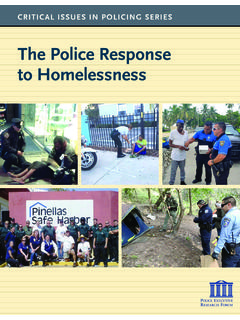
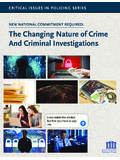
![[Page Intentionally Blank] - Police Executive …](/cache/preview/6/9/5/6/0/0/0/f/thumb-6956000f3f6abdc7d6fe85fa330b8ad5.jpg)
